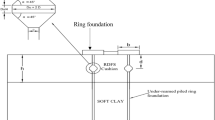Abstract
The demand for mineral products has increased substantially in recent years due to the rise in economic development. This results in the production of a significant volume of tailings waste. Due to this reason, the height (H) of existing tailings pond (TP) is frequently raised to accommodate the excess tailings released. This article presents a case study in which the stability of a TP, which was raised in phases to increase its storage capacity, is examined to understand its suitability for closure. While raising the heights in phases, geosynthetic reinforcements were introduced across the height of embankments to enhance the overall stability of TP. Furthermore, the height was increased by utilizing both downstream (D/S) as well as upstream (U/S) construction techniques. While examining the suitability of TP for closure, elaborate two-dimensional numerical simulations are performed to assess the overall stability of reinforced embankments of TP using finite-element-based software RS2. Initially, the stability analyses are carried out for the embankments at the end of final construction (i.e. after raising the height of TP) by utilizing the shear strength reduction technique. Subsequently, the stability of embankments is examined by incorporating the effect of seepage using partially coupled stress-seepage analyses. Results obtained from both analyses are expressed in terms of the critical strength reduction factor (SRF). Moreover, an attempt has been made to study the effect of beach width in determining the location of the phreatic line (which plays a vital role in assessing the overall stability of TP) within the TP. A decreasing trend in the SRF is observed when the beach widths behind the TP embankments are reduced from 5H to zero. Furthermore, the point of exit of phreatic line at the D/S slope of TP embankments is significantly lowered (for both D/S and U/S case) when the beach widths are increased from 0 to 5H. In addition, the critical SRF is observed to increase by 28.71% and 15.60% for D/S and U/S case respectively, when the geosynthetic reinforcements are used within the TP embankments. Overall, the TP in its current state is found to be stable, and with no further scope for raising, dry closure is recommended.




















Similar content being viewed by others
Abbreviations
- T :
-
Axial force
- L :
-
Beach width
- S a /g :
-
Design acceleration coefficient
- D/S:
-
Downstream
- c′ :
-
Effective cohesion
- σ′ :
-
Effective normal stress
- FOS:
-
Factor of safety
- FHWA:
-
Federal highway administration
- FEM:
-
Finite element method
- H :
-
Height
- K h :
-
Horizontal seismic coefficient
- I :
-
Importance factor
- ∅ ' :
-
Internal friction angle
- l :
-
Length of reinforcement
- γ max :
-
Maximum shear strain
- RF CR :
-
Reduction factor due to chemical degradation
- RF ID :
-
Reduction factor due to creep
- RF CD :
-
Reduction factor due to installation damage
- R :
-
Response reduction factor
- RS:
-
Rocscience
- τ :
-
Shear stress
- SRF:
-
Strength reduction factor
- TP:
-
Tailings pond
- T ult :
-
Ultimate tensile strength
- U/S:
-
Upstream
- Z :
-
Zone factor
References
Vick S G 1990 Planning, design, and analysis of tailings dams. BiTech Publishers Ltd
Gaudio D, Masini L and Rampello S 2018 A performance-based approach to design reinforced-earth retaining walls. Geotext. Geomembr. 46: 470–485. https://doi.org/10.1016/j.geotexmem.2018.04.003
Jia M, Zhu W and Xu C 2021 Performance of a 33m high geogrid reinforced soil embankment without concrete panel. Geotext. Geomembr. 49: 122–129. https://doi.org/10.1016/j.geotexmem.2020.07.008
Jing X, Chen Y, Williams D J, Serna M L and Zheng H 2019 Overtopping failure of a reinforced tailings dam: Laboratory investigation and forecasting model of dam failure. Water 11: 315. https://doi.org/10.3390/w11020315
Du C, Liang L, Yi F and Niu B 2021 Effects of geosynthetic reinforcement on tailings accumulation dams. Water 13: 2986. https://doi.org/10.3390/w13212986
Davies M P 2001 Impounded mine tailings: What are the failures telling us? CIM Bull. 94
Rico M, Benito G, Salgueiro A R, Díez-Herrero A and Pereira H G 2008 Reported tailings dam failures: a review of the European incidents in the worldwide context. J. Hazard. Mater. 152: 846–852. https://doi.org/10.1016/j.jhazmat.2007.07.050
do Carmo F F, Kamino L H Y, Junior R T, de Campos I C, do Carmo F F, Silvino G and Pinto C E F 2017 Fundão tailings dam failures: the environment tragedy of the largest technological disaster of Brazilian mining in global context. Perspect. Ecol. Conserv. 15: 145–151. https://doi.org/10.1016/j.pecon.2017.06.002
WISE 2020 Chronology of Major Tailings Dam Failures. World Information Service on Energy Uranium Project. http://www.wise-uranium.org/mdafst.html (accessed 25.01.23)
Glotov V E, Chlachula J, Glotova L P and Little E 2018 Causes and environmental impact of the gold-tailings dam failure at Karamken, the Russian Far East. Eng. Geol. 245: 236–247. https://doi.org/10.1016/j.enggeo.2018.08.012
Rotta L H S, Alcantara E, Park E, Negri R G, Lin Y N, Bernardo N and Souza Filho C R 2020 The 2019 Brumadinho tailings dam collapse: Possible cause and impacts of the worst human and environmental disaster in Brazil. Int. J. Appl. Earth Obs. Geoinf. 90: 102119. https://doi.org/10.1016/j.jag.2020.102119
Lyu Z, Chai J, Xu Z, Qin Y and Cao J 2019 A comprehensive review on reasons for tailings dam failures based on case history. Adv. Civ. Eng.. https://doi.org/10.1155/2019/4159306
United States Environmental Protection Agency 1994 Office of Water Regulations and Standards
Sinha A K, Havanagi V G, Sreekantan P G and Chandra S 2021 Geotechnical characterisation of zinc tailing waste material for road construction. Geomech. Geoengin.. https://doi.org/10.1080/17486025.2021.1990420
Dash R, Rajagopal K, Arnepalli D N 2016 Design and development of increased storage capacity of a lined pond at Hindustan Zinc Ltd. In: 6th Asian regional conference on geosynthetics, New Delhi, India
RS2 Version 11.003 2020 Finite element analysis for excavations and slopes. Rocscience, Inc., Ontario, Canada
Pappu A, Saxena M and Asolekar S R 2006 Jarosite characteristics and its utilisation potentials. Sci. Total Environ. 359: 232–243. https://doi.org/10.1016/j.scitotenv.2005.04.024
Saad B and Mitri H 2010 Staged construction analysis of surface tailings disposal facilities. Int. J. Min. Reclam. Environ. 24: 44–63. https://doi.org/10.1080/17480930902951293
Saad B and Mitri H 2011 Hydromechanical analysis of upstream tailings disposal facilities. J. Geotech. Geoenviron. Eng. 137: 27–42. https://doi.org/10.1061/(ASCE)GT.1943-5606.0000403
Coulibaly Y, Belem T and Cheng L 2017 Numerical analysis and geophysical monitoring for stability assessment of the Northwest tailings dam at Westwood Mine. Int. J. Min. Sci. Technol. 27: 701–710. https://doi.org/10.1016/j.ijmst.2017.05.012
Naeini M and Akhtarpour A 2018 Numerical analysis of seismic stability of a high centerline tailings dam. Soil Dyn. Earthq. Eng. 107: 179–194. https://doi.org/10.1016/j.soildyn.2018.01.019
Berg R R, Christopher B R and Samtani N C 2009 Design and construction of mechanically stabilized earth walls and reinforced soil slopes. United State, Federal High Way Administration (FHWA)
Indian Standard 1893 Part-1 2016 Criteria for earthquake resistant design of structures. Bureau of Indian Standards
Sitharam T G and Hegde A 2017 Stability analysis of rock-fill tailing dam: an Indian case study. Int. J. Geotech. Eng. 11: 332–342. https://doi.org/10.1080/19386362.2016.1221574
Garg S K 2020 Irrigation engineering and hydraulic structures. In: Water Resources Engineering (Vol. II). Khanna Publisher
Zhang C, Chai J, Cao J, Xu Z, Qin Y and Lv Z 2020 Numerical simulation of seepage and stability of tailings dams: a case study in Lixi, China. Water 12: 742. https://doi.org/10.3390/w10081048
Indian standard 7894 1975 Code of practice for the stability analysis of the earth dams. Bureau of Indian standard, New Delhi
Jewell R A 1986 Soil reinforcement with geotextiles. Construction Industry Research and Information Association
Justo J L, Morales-Esteban A, Justo E, Jiménez-Cantizano F A, Durand P and Vázquez-Boza M 2019 The dry closure of the Almagrera tailings dam: detailed modelling, monitoring results and environmental aspects. Bull. Eng. Geol. Environ. 78: 3175–3189. https://doi.org/10.1007/s10064-018-1342-2
Acknowledgements
Authors are thankful to International Coal Ventures Pvt. Ltd. (ICVL) for sharing all the data required in the present analyses. It would have been impossible to carry out the present work without the data received from ICVL.
Author information
Authors and Affiliations
Corresponding author
Ethics declarations
Disclosure statement
The author (s) reported no potential conflict of interest.
Rights and permissions
About this article
Cite this article
Singh, S., Kumar, A. & Sitharam, T.G. Stability investigation of embankments of a tailings pond for its dry closure: an Indian case study. Sādhanā 48, 89 (2023). https://doi.org/10.1007/s12046-023-02157-5
Received:
Revised:
Accepted:
Published:
DOI: https://doi.org/10.1007/s12046-023-02157-5




